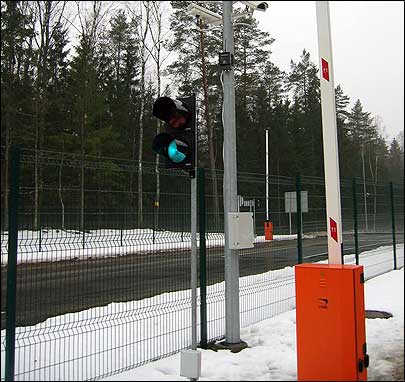Customs authorities in Kazakhstan and Lithuania are using RFID electronic seals (e-seals) on trucks passing through their countries—mostly traveling from China to Russia and into Western Europe—to prevent smuggling and theft of cargo transported within their borders on the way to other countries and ports.
Both nations are employing RFID tags, interrogators and antennas provided by Rockville, Md., company Hi-G-Tek, as well as local systems integrators, to make data about cargo movements available on their own databases. Two years ago, the Customs Control Agency of Kazakhstan began a limited deployment of the Automatic Delivery Control System (ADCS), including Hi-G-Tek RFID seals and interrogators, and software and integration by Kazak systems integrator Science Technical Center (NTC).

The customs agency attaches seals on the cargo doors of incoming trucks—which originate in China and are destined for Western Europe—to help track the movement of cargo across the country and ensure the trucks’ cargo doors have not been opened without authorization. On-board sensors on the seals monitor the state of each seal and provide alerts in the event of any attempts to tamper with it or open the doors, by transmitting a signal to the closest receiving RFID interrogator, located either on a highway or at border crossings.
Between 2,000 and 3,000 Chinese trucks make their way across the Kazak border or drive through the country en route to Russia and Western Europe on any given day, and more than $2 billion worth of goods cross through Kazakhstan annually. In the past, a truck’s cargo was often stolen and sold on the black market before the vehicle reached the Russian border.
The Kazak customs agency is using the RFID seals to combat this type of theft, which costs the Kazak government large amounts of revenue in lost taxes, as well as to streamline security by reducing the need for manual cargo inspection. By improving trade route security, the government also hopes to attract more commercial cargo traffic.
The Hi-G-Tek truck door seals with embedded RFID tags—which transmit at two frequencies: 433 MHz for long distance, 125 kHz for short range—fit over the handles of the truck door and seal it shut. Typically, the RFID chips have 10 kilobytes of memory. The tag on the seal transmits an alert in the event that the seal has been tampered with. In addition, it can send other data, such as the identity of the truck and driver, the type of cargo being transported, and, in some cases, the entire manifest.
After a truck arrives at customs at one of several Kazak border crossings, a Kazak customs agent inspects the vehicle. The doors are then closed and secured with an e-seal, says Micha Auerbach, Hi-G-Tek’s founder and CTO. Agents use a handheld device provided by Hi-G-Tek to capture the unique ID number on the seal’s RFID tag and transmit that data wirelessly to the customs agency’s back-end system. The NTC data-management software enables customs agents to track cargo, store data about the shipments as they cross the country, and receive alerts if a seal has been tampered with.
Customs agents can also use the handheld device to write data to the tag such as the driver’s name and truck ID, as well as the date and time an inspection occurred. After a sealed truck leaves customs, it travels across the country—mostly west to Russia, and in some cases east to China, along trade routes that were historically part of the Silk Road once traveled by camels and horses. In this case, Hi-G-Tek interrogators—known as outdoor data readers—are installed every 50 kilometers (31 miles) along the highway.
These fixed readers capture the tag’s data via 433 MHz transmission, and utilize GPRS connections to transmit that information to the customs agency’s back-end system. If the seal is tampered with at any point along the route, the agency receives an alert from the next interrogator that reads the tag, and can then dispatch a local government officer to stop the truck. Most cargo travels west from China, but empty trucks returning to that country are also sealed to prevent smuggling.
Although Lithuania is much smaller than Kazakhstan, it also sought a better way of ensuring no unauthorized person opens cargo doors of trucks passing through. The country shares borders with Latvia, Belarus, Poland and the Russian enclave of the Kaliningrad Oblast. Spanning only several hundred miles across, Lithuania required just two roadside outdoor fixed RFID readers to track the journey from one border to the other.
This system’s focus, explains Anthony Dublino, Hi-G-Tek’s managing director for Europe, the Middle East and Asia, is on sealing a truck’s cargo doors at one border, then ensuring there has been no tampering to the seal when it is removed at the other, rather than tracking the truck on the highway. The company installed the RFID system about 18 months ago, he says, and has been expanding it since then. As with Kazakhstan, most cargo arrives from China, while empty trucks return from the west. Hi-G-Tek—which, Auerbach says, almost always works with local integrators—is partnering with INTA, a Lithuanian system integrator.
The Lithuania Customs Authority (LCA) is using the system at eight border crossings—four on the Russian border (near Kaliningrad), and four on the border of Belarus. As in Kazakhstan, a truck’s doors are fitted with an RFID e-seal as the vehicle passes through customs, and data is stored on the seal’s tag using a handheld reader transmitting at 125 kHz.
If a truck is stored for any length of time in the border-crossing yard or terminal, a tilt-and-motion sensor function in the seal is activated. Thus, if anyone attempts to remove the truck’s cargo door or cut a hole in it, the sensor detects the seal’s movement and an alert is sent to Hi-G-Tek readers deployed in the area.
If something appears suspicious about a truck after it leaves a terminal, customs agents patrolling the highways in cars can pull over that vehicle. These officials carry Hi-G-Tek handheld interrogators and can scan the RFID seal to determine what cargo is in the truck and where it is destined, as well as the driver’s identity.
Once the truck reaches its final destination, the tag is read again with a handheld reader, to confirm the vehicle was not opened before the seal is removed and reused. All data is stored in an Oracle database using INTO software. The Lithuanian customs deployment has been growing, Dublino says, as the agency becomes accustomed with the system.
“They started with high-value or sensitive cargo,” Dublino says, including chemical or nuclear-related cargo. The next step has been securing trailers that open on top and are secured with a tarp over the cargo. Such shipments, which typically carry products such as cigarettes, are vulnerable to theft, since the tarps can be opened and reclosed without detection.
The customs agency is presently securing the tarps with a cable, joining together the two ends of the cable by means of a Hi-G-Tek RFID seal. The agency is using about 36 handheld readers to read seals.




